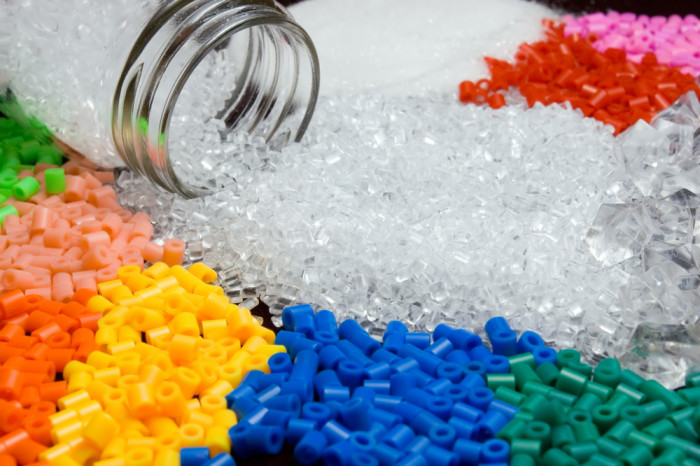Industrial vibration can be found in multiple areas of plastics processing and can help reduce the costs of materials and increase profit margins substantially. With the use of equipment such as vibratory screeners, companies are able to reuse regrind and efficiently sort out the usable material from that of which needs to be discarded. There are other ways that industrial vibration factors into the processing of plastic products, read on to learn more.
What exactly is “Regrind?” Regrind is a term that seems self-explanatory and if you guessed that the it applies to mechanically reduced plastic components/products, you guessed right. Much of the plastic waste used in this process usually comes from a pre-consumer source, for instance processed scraps or even unused thermoplastic materials from injection molding. If you were thinking that those bottles or plastic bags with the recycle emblem on it would be the obvious source, you’re not exactly wrong – this kind of commonly post-consumer waste is handled by specialized recycling companies, which is a whole other topic in itself.
How does the Regrind Process work? The method is simple. Plastic waste is processed through a grinding system which contains a chamber filled with rotating knives that mechanically cut the waste into shreds. The size is dependent on regulation set for their particular use. Those plastics that fall within the criteria for appropriate sizing are then mixed and melted into pellet forms with virgin resins, or compounds that come straight out of production which are not recycled. Most manufacturers agree that up to 30% of compatible regrind can be mixed without diminishing the mechanical properties of the primary material. The end product can then be shipped out for whatever demand calls for it. The regrind can also be fed back into whatever manufacturing process in which it came from initially and be used on a continuous basis or furthermore on a batch basis, once again this is dependent on that particular manufacturer’s specifications. This process gives manufacturers a great way to reduce material costs while also optimizing their material for it’s best use.
So where does Industrial Vibration come into play? Sizing regrind appropriately is a crucial part to the process. Since the leftover plastic varies in size from tiny dust-like particles up to a half of an inch, Vibratory Screeners are used to screen for specific sizes. This allows the manufacturer to have an efficient way to divide usable plastics from the non-usable leftovers. In the case of having dust-like particles present in your regrind, we highly recommend a double-deck screener. For instance, if you use a 4 mesh screen top deck and a 40 mesh lower screen deck, particles that pass through the 4 and set on the 40 are a suitable size for the regrind process. The fine particles that pass through the second deck should be discarded. We have multiple screen deck mesh sizing options you can choose from to customize your screener to your application. To allow a thorough mix of regrind and virgin plastics, the regrind particles should be as close as possible to the virgin resin size, since some oversized pieces may not feed well into the bridge of a hopper attached to the grinder.
Why is having dust-like granules or varying sizes of regrind plastic a big deal? It is important to note that the regrind plastic is melted down with virgin resins to create the end products specified plastic pellets. The varying sizes do not melt at same rate and and in the end may cause some variations in the molded product. However, though they are not serious flaws that would impact the overall quality or performance of the final product, the aesthetics could be affected due to small blemishes or discolorations the regrind may cause.
What do I do if my Vibratory Screener does not efficiently move the Regrind across the screen deck? We have also supplied Plastic Manufacturers with Vibratory Screeners fit with Ball Decks. If you were to see the regrind flow over a screen deck, the jagged corners and edges may inhibit it from flowing freely and becoming plugged in the screen deck openings. By fitting the Screener with a ball deck, it eliminates clogging in the openings. But how does it work? The motion of the Vibratory Motors such as Rotary Electrics, our most common vibratory motor for this application, allows rubber balls to bounce between the two screen decks, therefore knocking out any regrind that may be trapped in the screen openings. This not only allows better efficiency, but will also cut down on waste which in turn will save you money.
Is there any other use of Vibration in this industry? In short, absolutely. For manufacturers who wholesale their plastic pellets for molding and other plastic applications, they require some sort of packing process where the pellets can be loaded into parcels prior to shipment. A fantastic way to achieve maximum load with little effects due to the transport of product to the end user, is to use a Vibratory Compaction Table. Since packages are vibrated in transit, much of the material will settle and compact and if any extra space existed already, you will have then added additional empty space leaving your customers dissatisfied with the amount of product they had received. Craig Macklin took this topic a little further in a previous blog, click here to check it out! Vibratory Tables can also be used to settle molded or cast products as well.
In a nutshell, the use of vibration in the plastics world is crucial during the screening process. It provides a great way to quickly and efficiently divide usable materials from those whose size does not meet the specifications necessary for appropriate regrind. I am looking forward to expanding my knowledge in this industry and to share that knowledge with Cleveland Vibrator’s loyal movers & shakers. Until next time folks, #ShakeOn!
Photo Credit: examiner.com – (http://www.tdmiecs.in/images/s1.jpg)

Katy Sabo has been the Industrial Vibrator Duchess of The Cleveland Vibrator Company since 2014. The originator of #VibrationEducation, Katy has helped create CVC brand awareness across the globe and has made it her personal priority to share the importance of Industrial Vibration with anyone willing to listen! When she isn’t shaking things up in the Marketing Department, you can usually find her shopping with her favorite sidekicks (she’s the proud mom of two little ladies), going on long walks/runs with her favorite furry family members, or rooting on any Cleveland team with her diehard fan of a husband.
Follow us:
Share this blog post:



2 Responses to Using Vibration to Reduce Material Cost and Increase Profit Margins in the Plastics Industry